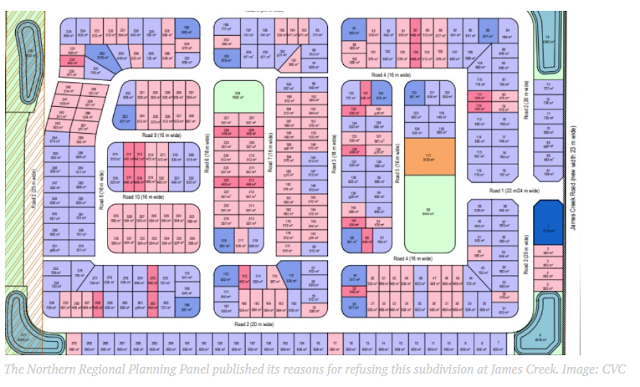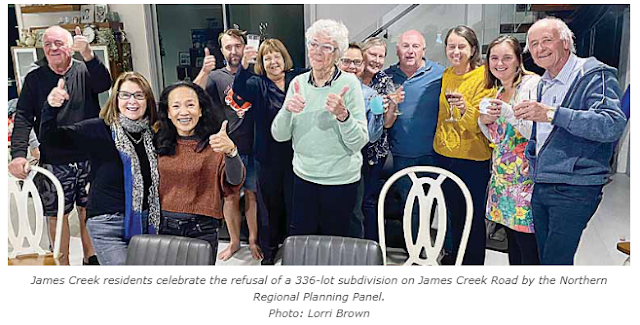Clarence Valley Independent, 12 July 2023:
 |
The Northern Regional Planning Panel has published its reasons for refusing a 336-lot subdivision at James Creek, a proposal that encountered hurdles satisfying council, which ultimately led to it not being recommended for approval.
When a development application DA was lodged with Clarence Valley Council in November 2020 for a staged residential subdivision on James Creek Road at James Creek, it proposed 342 lots, with 336 residential lots, a single park, and a neighbourhood centre for small scale retail.
Soon after the DA was lodged, The James Creek Residents Action Group was soon formed, and on December 7, 2020, the development application was withdrawn on behalf of owner Kahuna No 1 Pty Ltd.
A revised DA was lodged with CVC on November 4, 2021, for a 336-lot subdivision at 104 James Creek Road featuring 329 residential lots, one commercial lot, 4 drainage reserves and associated public space areas.
After working with CVC on the subdivision for more than a year, when Council staff completed their final assessment report for the Northern Regional Planning Panel NRPP, they recommended the subdivision be refused.
On June 29, 2023, when the NRPP met via videoconference to decide on the DA, after hearing submissions from 16 concerned locals, the subdivision was unanimously refused.
The NRPP published their reasons for refusing the DA last week, stating the application was refused for the reasons attached to the Council’s assessment report.
“The Panel agrees with the council assessment that the proposed inward facing urban structure, density, and proposed lot design relates poorly to the existing topographical form and presents a stark change to surrounding rural and semi-rural setting and character,” the determination stated.
“The Panel considers there is inadequate social infrastructure and services to support the proposed development including bus services and given the distances to local shops and facilities.
“The Panel also concluded there was insufficient consideration of flood evacuation, but notes the verbal advice provided by Council staff of an offer by the applicant to upgrade Gardiners Road to enable evacuation in a 1:100 year flood event.
“The Panel agrees with Council’s view that additional information and design amendments which might result in a more integrated ‘village’ style settlement may resolve these and other issues addressed in Council’s assessment report.”
In coming to its decision, the panel considered written submissions made during public exhibition and heard from all those wishing to address the panel.
The panel noted issues of concern included the impact on services, the lack of flood free access from Townsend along Gardiners Road, access to Austons Lane, stormwater management and flooding, impacts on adjoining rural land users and lack of buffers, inconsistency of development with planning proposal and adopted council policies, urban design and local character, traffic, transport and access, lack of Aboriginal cultural heritage assessment and consideration, a bushfire hazard, lack of public consultation and biodiversity.
The owner of lot 104 James Creek Road, Kahuna No 1 Pty Ltd now has the option of working with council to redesign the subdivision and relodge a revised DA, which they did with this DA, or decide not to pursue a subdivision on this site.
Australian Rural & Regional News, 5 July 2023:
Cheers of celebration and relief from James Creek residents erupted when the Northern Regional Planning Panel refused approval for a controversial $33 million 336 lot subdivision on James Creek Road.
The panel met via teleconference on Thursday June 29, to decide whether to approve the development application DA by MPD Investments at 104 James Creek Road for 329 residential lots, one commercial lot, four drainage reserves and two open space areas on the 33-hectare site.
Clarence Valley Council’s assessment report for the ‘regionally significant development’, which required it to be decided by the Northern Regional Planning Panel (NRPP), recommended the DA be refused over concerns with sewage, stormwater discharge, traffic issues, land use conflict, the urban structure and sensitivity of the proposed design to the surrounds.
When the DA was put on public exhibition three times in 2022 and 2023, council received 100 submissions and a petition with 171 signatures against the subdivision.
Clarence Valley Council was represented by Cr’s Ian Tiley and Peter Johnstone on the five person NRPP, after Cr Greg Clancy declared a conflict of interest as he had been to a public meeting with complainants about the subdivision.
NRPP Chair Diane Leeson said there were 18 people registered to speak to the panel about the DA.
Speakers included James Creek resident of 30 plus years, Pat Bowen, and Lorri Brown who spoke on behalf of the James Creek Residents Action Group stating the development would double the population of the village, which went against council’s targeted growth figures for James Creek.
Carolyn Cameron, whose husband’s family settled in James Creek in 1863 said she feared ‘that our close-knit rural community is going to be lost’.
An emotional Sharon Farlow, who holds a routine movement stock permit to move her cattle along James Creek Road which her family has done for 100 years, feared with increased traffic her livelihood would be impacted.
Neighbour Keira Fahey urged the NRPP to follow council’s refusal recommendation as the buffer zone between the subdivision and other properties was not adequate…..
Read the full article here.

.jpg)











